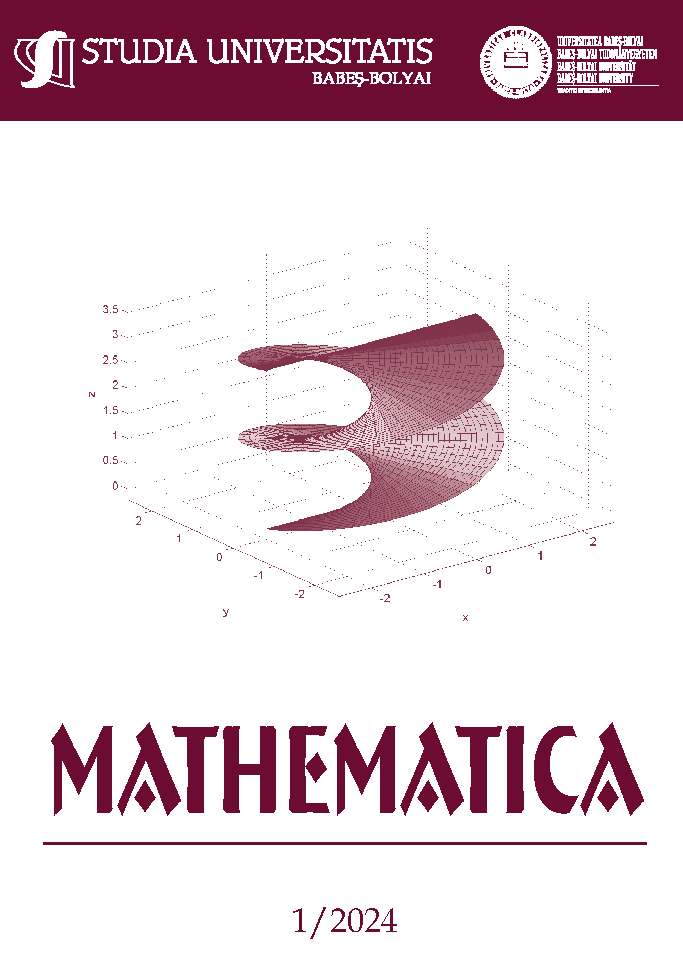Idempotent and nilpotent elements in octonion rings over Zₚ
DOI:
https://doi.org/10.24193/subbmath.2024.1.01Keywords:
Quaternion, octonion, ring, skew field, idempotent, nilpotentAbstract
In this paper, we show that the set O/Zp, where p is a prime number, does not form a skew field and discuss idempotent and nilpotent elements in the (finite) ring O/Zp. We provide examples and establish conditions for idempotency and nilpotency.
Mathematics Subject Classification (2010): 15A33, 15A30, 20H25, 15A03.
Received 27 July 2021; Accepted 14 December 2021
References
Ankeny, N.C., Sum of three squares, Proc. Amer. Math. Soc., 8(2)(1957), 316-319.
Aristidou, M., Demetre, A., A note on quaternion rings over Zp, Int. J. Alg., 3(15)(2009), 725-728.
Aristidou, M., Demetre, A., Idempotent elements in quaternion rings over Zp, Int. J. Alg., 6(5)(2012), 249-254.
Aristidou, M., Demetre, A., Nilpotent elements in quaternion rings over Zp, Int. J. Alg., 6(14)(2012), 663-666.
Ayoub, R., Ayoub, C., On the commutativity of rings, Am. Math. Mon., 71(3)(1964), 267-271.
Baez, J.C., The octonions, Bull. Amer. Math. Soc., 39(2002), 145-205. [7] Bourbaki, N., Elements of Mathematics – Algebra I, Hermann, 1974.
Cooper, S., Sums of five, seven and nine squares, Ramanujan J., 6(2002), 469-490.
Cooper, S., Hirschhorn, M., On the number of primitive representations of integers as sums of squares, Ramanujan J., 13(2007), 7-25.
Ebbinghaus, H.D., Hermes, H., Hirzebruch, F., Koecher, M., Mainzer, K., Neukirch, J., Prestel, A., Remmert, R., Numbers, Springer, NY, 1991.
Halici, S., Karatas, A., O/Zp Octonion algebra and its matrix representations, Palest.
J. Math., 6(1)(2017), 307-313.
Hardy, G.H., On the representations of a number as the sum of any number of squares, and in particular of five or seven, Proc. Nat. Acad. Sci., U.S.A., 4(1918), 189-193.
Hardy, G.H., On the representation of a number as the sum of any number of squares, and in particular of five, Trans. Amer. Math. Soc., 21(1920), 255-284.
Herstein, I.N., Topics in Algebra, 2nd ed., Wiley, 1975.
Herstein, I.N., Wedderburn’s theorem and a theorem of Jacobson, Am. Math. Mon., 68(3)(1961), 249-251.
Hirano, Y., Tominaga, H., Rings in which every element is the sum of two idempotents, Bull. Austral. Math. Soc., 37(2)(1988), 161-164.
Hurwitz, A., Über die Komposition der quadratischen Formen von Beliebig Vielen Variabeln, Nachr. Ges. Wiss. Göttingen, (1898), 309-316.
Jacobson, N., Structure theory for algebraic algebras of bounded degree, Ann. of Math., 46(1945), 695-707.
Malekian, E., Zakerolhosseini, A., OTRU: A non-associative and high-speed public key cryptosystem, 15th CSI International Symposium on Computer Architecture and Digital Systems, Iran, 2010, 83-90.
Miguel, C.J., Serodio, R., On the structure of quaternion rings over Zp, Int. J. Alg., 5(27)(2011), 1313-1325.
Mosic, D., Characterizations of k-potent elements in rings, Ann. Mat. Pura Appl., 194(4)(2015), 1157-1168.
Pierce, R.S., Associative Algebras, Springer, 1982.
van der Poorten, A., Concerning commuting, Austral. Math. Soc. Gazette, 194(1994), 68.
Schafer, R., An Introduction to Nonassociative Algebras, Academic Press, 1996.
Serre, J.P., A Course in Arithmetic, Springer, 1973.
Tian, Y., Matrix representations of octonions and their applications, Adv. Appl. Clifford Algebr., 10(1)(2000), 61-90.
Trenkler, G., Baksalary, O.M., On k-potent matrices, Electron. J. Linear Algebra, 26(2013), 446-470.
Downloads
Published
How to Cite
Issue
Section
License
Copyright (c) 2024 Studia Universitatis Babeș-Bolyai Mathematica

This work is licensed under a Creative Commons Attribution-NonCommercial-NoDerivatives 4.0 International License.


